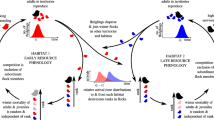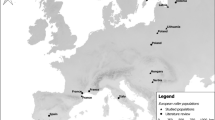Summary
Classical models of breeding habitat selection rarely deal with the question of information gathering for patch quality assessment. In this paper, we present two models comparing the fitness outcomes of behavioural strategies based on conspecific reproductive success as a cue to assess local environmental quality before selecting a new breeding habitat. The models deal with two phases of the life-cycle of a territorial migratory species: recruitment to a breeding population (model 1) and breeding site fidelity of subsequent breeding attempts (model 2). The first model shows that prospecting breeding patches before recruiting is the best strategy if the environment is predictable and contains a low proportion of good patches, even if it implies losing a breeding opportunity. The second model shows that dispersing after a breeding attempt according to the patch’s breeding success rather than the individual’s own success is the best strategy if the environment is patchy. These results underline the importance of studying the spatio-temporal variations of factors affecting reproductive success when considering the importance of habitat selection strategies based on conspecifics. Moreover, they allow the understanding of individual behaviour patterns observed in natural populations and their potential consequences at the metapopulation level.
Similar content being viewed by others
References
Abrahams, M.V. (1986) Patch choice under perceptual constraints: A cause for departures from an ideal free distribution. Behav. Ecol. Sociobiol. 19, 409–415.
Alexander, R.D. (1974) The evolution of social behavior. Ann. Rev. Ecol. Syst. 5, 325–383.
Baker, R.R. (1993) The function of post-fledging exploration: A pilot study of three species of passerines ringed in Britain. Omis Scand. 24, 71–79.
Bensch, S. and Hasselquist, D. (1991) Territory infidelity in the polygynous great reed warbler Acrocephalus arundinaceus: The effect of variation in territory attractiveness. J. Anim. Ecol. 60, 857–871.
Beletsky, L.D. and Orians, G.H. (1991) Effects of breeding experience and familiarity on site fidelity in female red-winged blackbirds. Ecology 72, 787–796.
Bernstein, C., Kacelnik, A. and Krebs, J.R. (1988) Individual decisions and the distribution of predators in a patchy environment. J. Anim. Ecol. 57, 1007–1026.
Bollinger, E.K. and Gavin, T.A. (1989) The effects of site quality on breeding-site fidelity in Bobolinks. Auk 106, 584–594.
Boulinier, T., Danchin, E., Monnat, J.-Y., Doutrelant, C. and Cadiou, B. (1996) Timing of prospecting and the value of information in a colonial breeding bird. J. Avian Biol. 27, 252–256.
Boyd, R. and Richerson, P.J. (1988) An evolutionary model of social learning: The effects of spatial and temporal variations. In Social Learning: Psychological and Biological Perspectives (T.R. Zentall and B.G. Galef, Jr, eds), pp. 29–48. Lawrence Erlbaum Associates, Hillsdale, NJ.
Bradley, J.S. and Wooller, R.D. (1991) Philopatry and age of first-breeding in long-lived birds. Acta XX Cong. Int. Orn., 1657–1665.
Brooke, M. de L. (1978) The dispersal of female manx sherwaters Puffinus puffinus. Ibis 120, 545–551.
Brown, C.R. and Brown M.B. (1992) Ectoparasitism as a cause of natal dispersal in cliff swallows. Ecology 73, 1718–1723.
Brown, C.R., Struchbury, B.J. and Walsh, P.D. (1990) Choice of colony size in birds. TREE 5, 398–403.
Cadiou, B. (1993) L’accession à la reproduction: un processus social d’ontogenèse. Cas de la mouette tridactyle (Rissa tridactyld). Thèse de doctorat, Université de Rennes.
Cadiou, B., Monnat, J.-Y. and Danchin, E. (1994) Prospecting in the kittiwake, Rissa tridactyla: Different behavioural patterns and the role of prospecting in recruitment. Anim. Behav. 47, 847–856.
Caswell, H. and John, A.M. (1992) From the individual to the population in demographic models. In Individual-based Models and Approaches in Ecology: Populations, Communities and Ecosystems (D.L. DeAngelis and L.J. Gross, eds), pp. 36–61. Chapman and Hall, New York.
Chabrzyk, G. and Coulson, J.C. (1976) Survival and recruitment in the herring gull Larus argentatus. J. Anim. Ecol. 45, 187–203.
Clark, C. and Mangel, M. (1984) Foraging and flocking strategies: Information in an uncertain environment. Am. Nat. 123, 626–641.
Cody, M.L. (1985) An introduction to habitat selection in birds. In Habitat Selection in Birds (M.L. Cody, ed.), pp. 3–56. Academic Press, London.
Coulson, J.C. (1966) The influence of pair-bond and age on the breeding biology of the kittiwake gull Rissa tridactyla. J. Anim. Ecol. 35, 269–279.
Coulson, J.C. and Nève de Mévergnies, G. (1992) Where do young kittiwake Rissa tridactyla breed, philopatry or dispersal? Ardea 80, 187–197.
Dale, S., Amundsen, T., Lifjeld, J.T. and Slagsvold, T. (1990) Mate sampling behaviour of female pied flycatchers: Evidence for active mate choice. Behav. Ecol. Sociobiol. 27, 87–92.
Danchin, E. and Monnat, J.-Y. (1992) Population dynamics modelling of two neighbouring Kittiwake Rissa tridactyla colonies. Ardea 80, 171–180.
Danchin, E., Cadiou, B., Monnat, J.-Y. and Estrella, R.R. (1991) Recruitment in long-lived birds: Conceptual framework and behavioural mechanisms. Acta XX Cong. Int. Orn., 1641–1656.
Desrochers, A. and Magrath, R.D. (1993) Environmental predictability and remating in European blackbirds. Behav. Ecol. 4, 271–275.
Forbes, L.S. and Kaiser, G.W. (1994) Habitat choice in breeding seabirds: When to cross the information barrier. Oikos 70, 377–384.
Fretwell, S.D. and Lucas, H.L. (1970) On territorial behavior and other factors influencing habitat distribution in birds. I. Theoretical developments. Acta Biotheoretica 19, 16–36.
Furness, R.W. and Birkhead, T.R. (1984) Seabird colony distribution suggest competition for food supplies during the breeding season. Nature 311, 655–656.
Furness, R.W. and Monaghan, P. (1987) Seabird Ecology. Blackie, Glasgow.
Gauthier, G. (1990) Philopatry, nest-site fidelity, and reproductive performance in Bufrleheads. Auk 107, 126–132.
Gavin, T.A. and Bollinger, E.K. (1988) Reproductive correlates of breeding-site fidelity in Bobolinks (Dolichonyx oryzivorus). Ecology 69, 96–103.
Greenwood, P.J. (1980) Mating systems, philopatry and dispersal in birds and mammals. Anim. Behav. 28, 1140–1162.
Harris, M.P. (1983) Biology and survival of the immature Puffin Fratercula arctica. Ibis 125, 56–73.
Holt, R.D. (1987) Population dynamics and evolutionary processes: The manifold roles of habitat selection. Evol. Ecol. 1, 331–347.
Johnson, M.L. and Gaines, M.S. (1990) Evolution of dispersal: Theoretical models and empirical tests using birds and mammals. Ann. Rev. Ecol. Syst. 21, 449–480.
Klopfer, P.H. and Ganzhorn, J.U. (1985) Habitat selection: Behavioural aspects. In Habitat Selection in Birds (M.L. Cody, ed.), pp. 435–453. Academic Press, London.
Krebs, J.R. and Inman, A.J. (1992) Learning and foraging: Individuals, groups, and populations. Am. Nat. 140, S63-S84.
Lebreton, J.-D. (1981) Contribution à l’étude de la dynamique des populations d’oiseaux. Modèles mathématiques en temps discret. Thèse de doctorat, Université Claude Bernard, Lyon.
Loye, J.E. and Carroll, S.P. (1991) Nest ectoparasite abundance and cliff swallow colony site selection, nestling development, and departure time. In Bird-Parasite Interactions: Ecology, Behaviour and Evolution (J.E. Loye and M. Zuk, eds), pp. 222–241. Oxford University Press, Oxford.
Mangel, M. and Clark, C.W. (1988) Dynamic Modelling in Behavioural Ecology. Princeton University Press, Princeton, NJ.
McNicholl, M.K. (1975) Land site tenacity and group adherence in relation to habitat. Auk 95, 98–104.
McPeek, M.A. and Holt, R.D. (1992) The evolution of dispersal in spatially and temporally varying environments. Am. Nat. 140, 1010–1027.
Mead, C.J. and Harrison, J.D. (1979) Sandmartin movements within Britain and Ireland. Bird Study 26, 73–86.
Monnat, J.-Y., Danchin, E. and Estrella, R.R. (1990) Evaluation de la qualité du milieu dans le cadre de la prospection et du recrutement: le squatterisme chez la Mouette tridactyle. CR. Acad. Sei. Paris 311, 391–396.
Morris, D.W. (1987) Spatial scale and the cost of density-dependent habitat selection. Evol. Ecol. 1, 379–388.
Orians, G.H. and Wittenberger, J.F. (1991) Spatial and temporal scales in habitat selection. Am. Nat. 137, S29-S49.
Payne, B.P. and Payne, L.L. (1993) Breeding dispersal in indigo bunting: Circumstances and consequences for breeding success and population structure. Condor 95, 1–14.
Podolsky, R.H. and Kress, S.K. (1989) Factors affecting colony formation in Leach’s storm petrel. Auk 106, 332–336.
Porter, J.M. and Coulson, J.C. (1987) Long-term recruitment to the breeding group, and the quality of recruits at a kittiwake Rissa tridactyla colony. J. Anim. Ecol. 56, 675–689.
Potts, G.R., Coulson, J.C. and Deans, I.R. (1980) Population dynamics and breeding success of the shag, Phalacrocorax aristotelis, on the Farne islands, Northumberland. J. Anim. Ecol. 49, 465–484.
Pöysä, H. (1992) Group foraging in patchy environments: The importance of coarse level local enhancement. Omis Scand. 23, 159–166.
Pulliam, H.R. and Danielson, B.J. (1991) Sources, sinks, and habitat selection: A landscape perspective on population dynamics. Am. Nat. 137, S50-S66.
Ray, C., Gilpin, M. and Smith, A.T. (1991) The effect of conspecific attraction on metapopulation dynamics. Biol. J. Linn Soc. 42, 123–134.
Reed, J.M. and Dobson, A.P. (1993) Behavioural constraints and conservation biology: Conspecific attraction and recruitment. TREE 8, 253–256.
Reed, J.M. and Oring, L.W. (1992) Reconnaissance for future breeding sites by spotted sandpipers. Behav. Ecol. 3, 310–317.
Rosenzweig, M.L. (1991) Habitat selection and population interactions: The search for mechanism. Am. Nat. 137, S5-S28.
Shettleworth, S.J., Krebs, J.R., Stephens, D.W. and Gibbons, J. (1988) Tracking a fluctuating environment: A study of sampling. Anim. Behav. 36, 87–105.
Shields, W.M., Crook, J.R., Hebblethwaite, M.L. and Wiles-Ehmann, S.S. (1988) Ideal free coloniality in the swallows. In The Ecology of Social Behaviour (C.N. Slobochikoff, ed.), pp. 189–228. Academic Press, London.
Slagsvold, T. and Lifjeld, J.T. (1994) Polygyny in birds: The role of competition between females for male parental care. Am. Nat. 143, 59–94.
Smith, A.T. and Peacock, M.M. (1992) Conspecific attraction and the determination of metapopulation colonization rates. Conserv. Biol. 4, 320–323.
Stamps, J. A. (1987) Conspecifics as cues to territory quality: A preference of juvenile lizards (Anolis aeneus) for previously used territories. Am. Nat. 129, 629–642.
Stamps, J.A. (1988) Conspecific attraction and aggregation in territorial species. Am. Nat. 131, 329–347.
Stamps, J.A. (1991) The effect of conspecifics on habitat selection in territorial species. Behav. Ecol Sociobiol. 28, 29–36.
Stamps, J.A. (1994) Territorial behavior: Testing the assumptions. Adv. Study Behav. 23, 173–232.
Stamps, J.A. and Krishman, V.V. (1990) The effect of settlement tactics on territorial sizes. Am. Nat. 135,527–546.
Stearns, S.C. (1992) The Evolution of Life Histories. Oxford University Press, Oxford.
Stephens, D.W. (1987) On economically tracking a variable environment. Theor. Pop. Biol. 32, 15–25.
Sullivan, M.S. (1994) Mate choice as an information gathering process under time constraint: Implications for behaviour and signal design. Anim. Behav. 47, 141–151.
Switzer, P.V. (1993) Site fidelity in predictable and unpredictable habitats. Evol. Ecol. 7, 533–555.
Sydeman, W.J. and Emslie, S.D. (1992) Effects of parental age on hatching asynchrony, egg size and third-chick disadvantage in western gulls. Auk 109, 242–248.
Tamm, S. (1987) Tracking varying environments: Sampling by hummingbirds. Anim. Behav. 35, 1725–1734.
Templeton, J.J. and Giraldeau, L.-A. (1995) Patch assessment in foraging flocks of European starlings: Evidence for the use of public information. Behav. Ecol. 6, 65–72.
Valone, T.J. (1989) Group foraging, public information, and patch estimation. Oikos 56, 357–363.
Valone, T.J. (1993) Patch information and estimation: A cost of group foraging. Oikos 68, 258–266.
Valone, T.J. and Giraldeau, L.-A. (1993) Patch estimation by group foragers: What information is used? Anim. Behav. 45, 721–728.
Waser, P.M. (1985) Does competition drive dispersal? Ecology 66, 1170–1175.
Weimerskirch, H. (1990) The influence of age and experience on breeding performance of the antarctic fulmar, Fulmarus glacialoides. J. Anim. Ecol. 59, 867–875.
Wiens, J.A. (1985) Habitat selection in variable environments: Shrub-steppe birds. In Habitat Selection in Birds (M.L. Cody, ed.), pp. 227–251. Academic Press, London.
Yoccoz, N.G., Engen, S. and Stenseth, N.C. (1993) Optimal foraging: The importance of environmental stochasticity and accuracy in parameter estimation. Am. Nat. 141, 139–157.
Zicus, M.C. and Hennes, S.K. (1989) Nest prospecting by common goldeneyes. Condor 91, 807–812.
Author information
Authors and Affiliations
Rights and permissions
About this article
Cite this article
Boulinier, T., Danchin, E. The use of conspecific reproductive success for breeding patch selection in terrestrial migratory species. Evol Ecol 11, 505–517 (1997). https://doi.org/10.1007/s10682-997-1507-0
Issue Date:
DOI: https://doi.org/10.1007/s10682-997-1507-0




